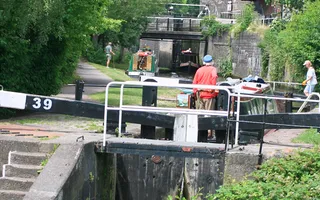Josiah Wedgwood, world-renowned pottery manufacturer of the 1700s, needed a better way than bumpy packhorse tracks to get raw materials into his factories and transport his delicate products out. With Wedgwood as one of the main benefactors, the great engineer James Brindley was employed and the Trent & Mersey Canal opened in 1777. The Potteries could now explode into mass production and export to the world, starting their journey by canal boat. Today, it's still ceramics heaven with living heritage shaping the skyline.
Canal walk to Harecastle Tunnel
The 6km walk along the Trent & Mersey Canal captures the excitement of a canal born for pottery.
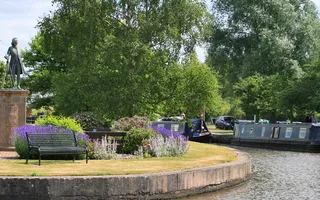
Canal: Trent & Mersey
Start: Etruria Junction OS Grid ref: SJ871469 Postcode: ST1 4BT
Finish: Harecastle Tunnel OS Grid ref: SJ849517 Postcode: ST6 4PX
Distance: 6km / 3¾ miles
Route instructions
Start: Etruria Junction is where the Caldon Canal meets the Trent & Mersey Canal, in the bottle-oven landscape of the region celebrated famously across the globe as 'The Potteries'. Thanks to the creation of the Trent & Mersey and subsequent canals, the Potteries exploded into mass production, and living ceramics heritage is everywhere.
1. Opened in 1779, the Caldon was primarily built to transport limestone from Cauldon quarries into the potteries and elsewhere, and is now a gem for nature and heritage. The Caldon slips quietly away eastwards from the junction, passing a formal statue of James Brindley, ‘Father of English Canals'.
2. Etruria Industrial Museum is housed in Jesse Shirley's Bone & Flint Mill, an important supplier to the pottery industry from the 1800s right up to 2011. Opened to the public by Fred Dibnah in 1991, it is now Grade II*-listed, and special ‘steaming' weekends offer the thrill of seeing the simplicity of Victorian genius at work. The fires of history are literally set alight, cogs turn cogs, that turn cogs, that crush bones and grind flint stone as if it was butter.
3. Follow the towpath, passing the forge where you might see a blacksmith at work, and head northwards from the three locks in the Stoke Lock Flight.

4. Just beyond the A53 bridge, rather modestly at the edge of a parking area, stands the Grade II*-listed Round House. Built in 1769 and the last remaining part of the original Wedgwood Pottery Works, this circular building was apparently used for grinding raw materials, and as a counting house and stable. Cross the bridge to follow the towpath on the opposite bank. Festival Park, built for the 1986 National Garden Festival, now spreads along the canalside with a marina, an aqua park and a hotel incorporating Josiah Wedgwood's Grade II-listed former home, Etruria Hall.
5. Passing through increasingly leafy surroundings, the towpath swaps back to the opposite side of the canal at Turnover Bridge 119.
6. Just beyond Newport Lane Bridge 123, on the opposite bank is the Grade II-listed listed Oliver's Mill, former calcining kilns where bone and flint were burned before grinding.
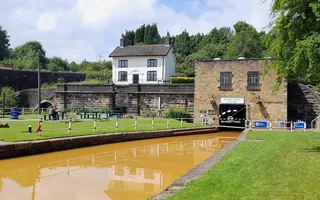
7. At Mill Bridge 125, a detour leads to the Grade II*-listed Middleport Pottery and its huge bottle kiln, rescued from closure by The Prince's Regeneration Trust. The last working Victorian pottery in Britain, it still uses original machinery and is the only place in the world using a 200-year-old decorating technique. It is the home of Burleighware, the world-famous blue and white floral tableware manufactured here since 1888. Back on the towpath, there are fabulous views to the pottery across the canal.
8. Westport Lake is an important overwintering site for water birds and a stop-off for migrating birds, so you may be lucky enough to see birds such as Great Crested Grebe and Fieldfare or even the blue flash of a kingfisher. There's also a Visitor Centre and café.
9. You may notice a change in the colour of the canal water as you walk through a leafy stretch. Not unlike tomato soup, the water's rusty hue is blamed on seepage of iron ore from the first Harecastle Tunnel engineered by James Brindley in 1777, but abandoned due to subsidence in 1914.
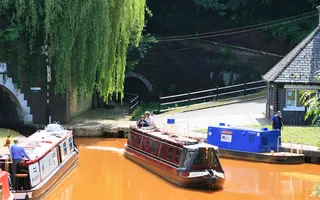
End: The second tunnel, nearly 3,000 yards long and sitting alongside Brindley's, was built by Telford in 1827 and this is the route boaters use today. You could carry on up over the tunnel to the north entrance and get a train back from Kidsgrove. Otherwise hop on a bus or retrace your steps back to Etruria from a new perspective.

Last Edited: 28 May 2025
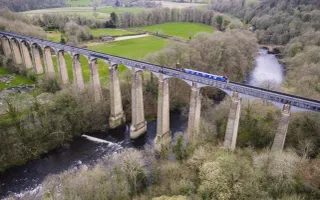

Stay connected
Sign up to our newsletter and discover how we protect canals and help nature thrive


